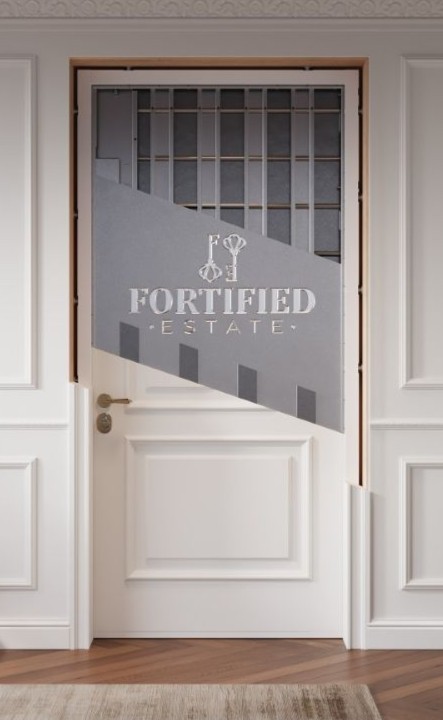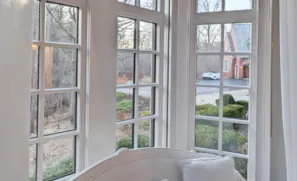Creating A Home Gun Vault Room
Last Updated January 17th, 2022
Table of Contents
- What Is A Gun Safe Room
- Panic Room Similarities & Differences
- Planning And Building Your Gun Vault Room
- Example Armoring Products
Summary Highlights:
- Gun rooms have special characteristics that differ from standard safe rooms
- Placement in a discreet spot is helpful
- Doors are the most important aspect to secure, next is walls
- Forced entry resistance is of primary importance, as well as fire protection.
What Is A Gun Safe Room?
A gun safe room or vault room is a highly secured room used to store your valuables (be it guns, art, currency, or precious metals). Clients generally fill walls with displayed firearms and significantly harden the gun room against fires, storms, and all manners of human attack.
Panic Rooms vs Gun Safe Rooms: The Difference
As with panic rooms, firearm vault rooms require security from all manner of attacks, whether from a burglar, home invader, or just a mischievous child. All entry points need protection. A gun safe room does differ in construction from a panic room in the duration and type of protection needed; recommended placement, and; fire and safety features. More details below:
A person only uses a panic room when there’s an obvious threat. Therefore, it must withstand attack until police can arrive. With a gun vault room, burglary attempts may occur when a homeowner is out, allowing much more time for forcible entry. A home security system is vital in minimizing the available attack time. All systems have some vulnerabilities, though.
Counterintuitively, a panic room has minimal need for fire resistance: it does not make sense for occupants to stay inside a burning building when they can run outside. Firearms, of course, can’t run outside themselves. Clients with elaborate or rare collections may require high levels of fire and smoke protection in their gun vault rooms.
Ballistic protection is vital for a panic room: a stray bullet may result in an occupant’s death. In a home gun room, only property is occupying the room. If an attacker fires their weapon towards the room, the risk is only to one’s property (assuming the room isn’t storing dangerous combustibles!).Therefore, bullet resistance in the doors and walls of the gun vault often isn’t needed. The saved money can instead be applied towards resisting forced entry, which is of primary concern.
In addition to security risks, a gun vault also faces safety risks. This comes in the form of well-meaning children (or adults) accessing the room’s firearms, unaware of their limits.In most cases we recommend clients locate their panic room where it can be used for normal use when not in an emergency situation. The room’s security function can easily be disguised.In most gun rooms firearms are visibly and accessibly placed on the wall for display. Therefore, it is best that the room be one which is not easily accessible to anyone but authorized users.
Planning & Building A Gun Room
How to Build Your Custom Gun Safe Room:
- Identify the location to build your gun room in your home
- Select a gun room door
- Plan window and wall armoring
- Plan fireproofing and ventilation measures
- Plan weapon display options
- Install security features and materials
- Train for proper use
Step 1: Identify The Location To Build Your Custom Gun Room
Common mistake: A gun room ends up needing frequent access due to dual-use, thus degrading its safety and security.
Our recommendations for placing your gun room:
- Choose a relatively discreet location, such as a closet, basement space, or mechanical room. Unless you also plan to run there in an emergency, it’s okay for the gun vault room to be distant.
- Ensure the room’s designation as a gun room is practical. Avoid selecting a space your family frequently uses for mundane purposes, such as a laundry room.
- If possible, select an area with some natural fire resistance, such as one that uses a concrete exterior wall or is in the basement.
- Consider your firearm collection and ensure the selected space can contain it.
- If renovating an existing room to build your gun safe, select a space with few obstructions (e.g., duct and pipework) and few entry points (e.g., doors and windows) — this allows for cost-effective armoring and installation.
Step 2: Select Gun Room Vault Door
Common mistake: a walk-in gun door that sticks out like a sore thumb.
We recommend the following when selecting a gun room door:
- Unlike a panic room, a gun safe room must be in the normally locked position.
- The gun room door needs to lock securely from the outside, not requiring an individual inside to turn a spindle to throw the bolts, for example.
- The gun vault door must not have a commercial or militaristic appearance. A cold, steel door will attract attention and directly guide a burglar to focus their attention there.
- Therefore, select a secure door clad to match your home’s aesthetic.
- The most important aspect of your door will be its ability to withstand forced entry attacks. A criminal may attack with anything from a pry bar to a powered saw. The lock may be subject to attempted manipulation.
- We recommend selecting a door protected from firearm attacks that could defeat a door’s lock system.
- However, full bulletproofing of the door is not required for most gun safe rooms. For a room not designed to be occupied by humans, clients are often okay with the possibility of a bullet penetrating the door and merely causing some damage to their property – so long as criminals cannot attain entry this way.
Step 3: Plan Window and Wall Armoring
Common mistake: breakable glass windows and sheetrock walls compromise gun room entrance security.
Our recommendations on securing other entry points:
- As per above, select a room with minimal access points, including a limited wall perimeter. Or, select already-reinforced walls (such as a foundational concrete wall).
- Secure your walls with high-security panels that can withstand bladed and blunt weapon attacks, such as Level 3 of our Ballistic Fiberglass panels. Avoid flammable materials.
- Replace standard windows with high-security options. We recommend a security standard of P6B or above, designed to stop 30-50 ax strikes. Many clients upgrade to ballistic options.
- Endeavor to blend the design of the new window into your home. We offer fully custom forced entry and ballistic residential windows.
Step 4: Plan fireproofing and ventilation
Common mistake: Intermingled fire resistance and security are sub-par in a gun safe.
A gun vault room provides more flexibility than a gun safe. We recommend the following:
- Select fire-resistant and collapse-resistant wall armoring, such as steel or ballistic fiberglass. If building a new home, consider masonry.
- Use type-x drywall and other fire minimization materials
- Seal cracks around ductwork and pipes with flame retardent foams and caulking
- Minimize flammable furniture and drapery in the gun room; where necessary, apply flame retardant sprays.
- For expensive guns, heirlooms, or antique firearms, consider a double protection measure of placing these in a fire-resistant container inside the gun room. As the space is already secure, the container merely needs to be highly fire-resistant.
Step 5: Plan Weapon Display
Common mistake: Firearms are left stacked near each other, limiting the collection’s visibility and leaving them susceptible to damage.
For your home gun safe room, we recommend the following display tips:
- Carefully measure the wall space you expect to have following its fortification.
- Invest in a fire-resistant, steel-based modular gun rack system. Our team can advise you on brands used by prior clients.
- Create a list of the number of pistols, rifles, and any irregular-shaped items you’ll be displaying.
- Based on the modular display system, determine the space needed to lay these out. For high-density storage, consider stacking multiple guns next to each other on the system in a vertical position.
- With the approximate plan, select the hooks and containers needed for your firearms and ammunition to attach correctly to the racks.
Step 6: Install Features
Common mistake: Improperly installed features negate their security and safety capabilities.
Install video
Our team recommends the following to complete your project:
- If working with Fortified Estate for your vault room doors, windows, or walls for a new home build, reach out early in the project so that we can recommend possible changes to blueprints before construction.
- For installation, work with a licensed and bonded contractor.
- Most contractors experienced with door and window installation are skilled enough to install high-security doors as well.
- Our team can advise your installation team on methods and tips.
- If you don’t have a gun vault room contractor or builder, we can often refer you to contractors who have worked with other clients in the same city.
Step 7: Train Yourself and Your Family
Common mistake: Despite rigorous security measures, a gun-safe room becomes vulnerable due to human error.
Here are some tips on making the most of the gun vault room in your house:
- Personally review all details for safely opening and locking the gun room entrance.
- Carefully ensure the gun room door cannot be opened from the outside by a child or guest (such as knowing where the key is stored).
- Ensure you and, if applicable, other family members have a plan in place to always leave the door locked when the gun room is unoccupied.
- However, in the improbable event a child gets locked in, ensure household members know how to unlock the door from the inside.
- Personally review safety details for safely storing guns and ammunition on display racks.
- Determine what to do in various emergencies, such as a home invasion or fire. Do you plan to access the gun vault room quickly or immediately leave and call for help?
- Train your family several times on how to respond based on various threatening situations. Plans may differ based on the location the person is in at the time.









